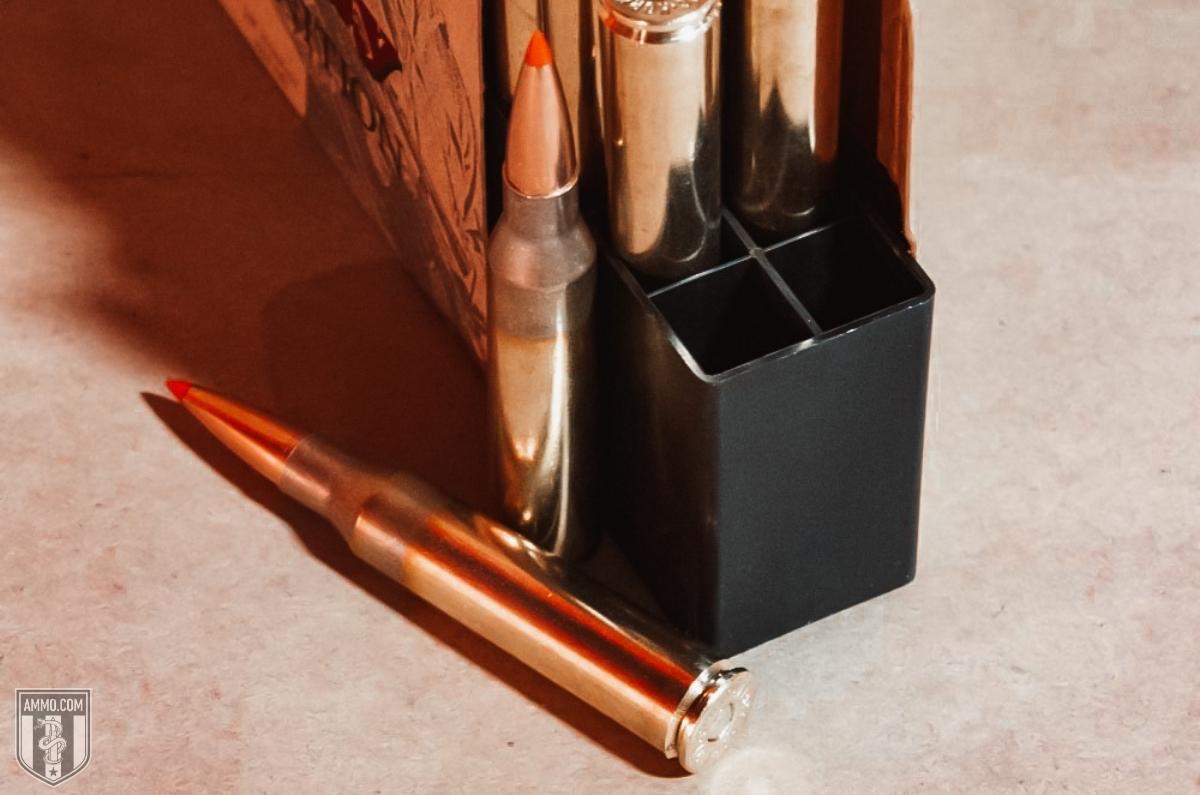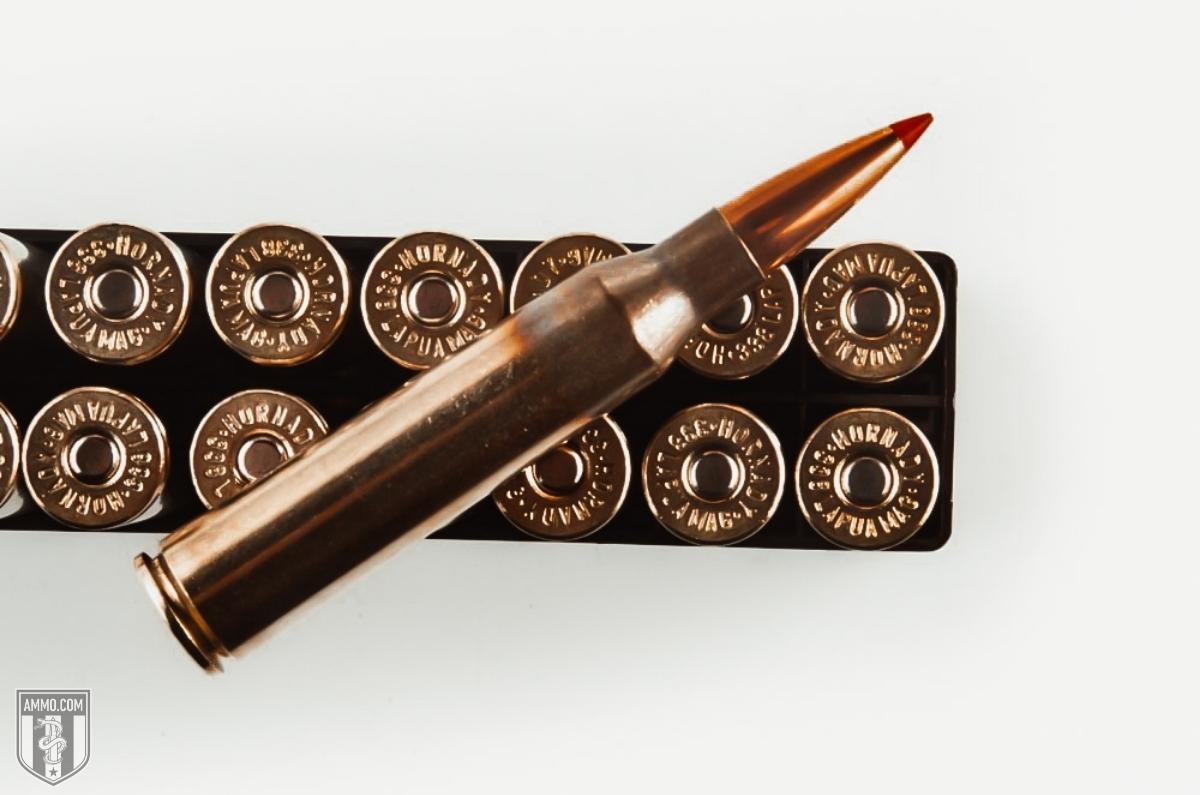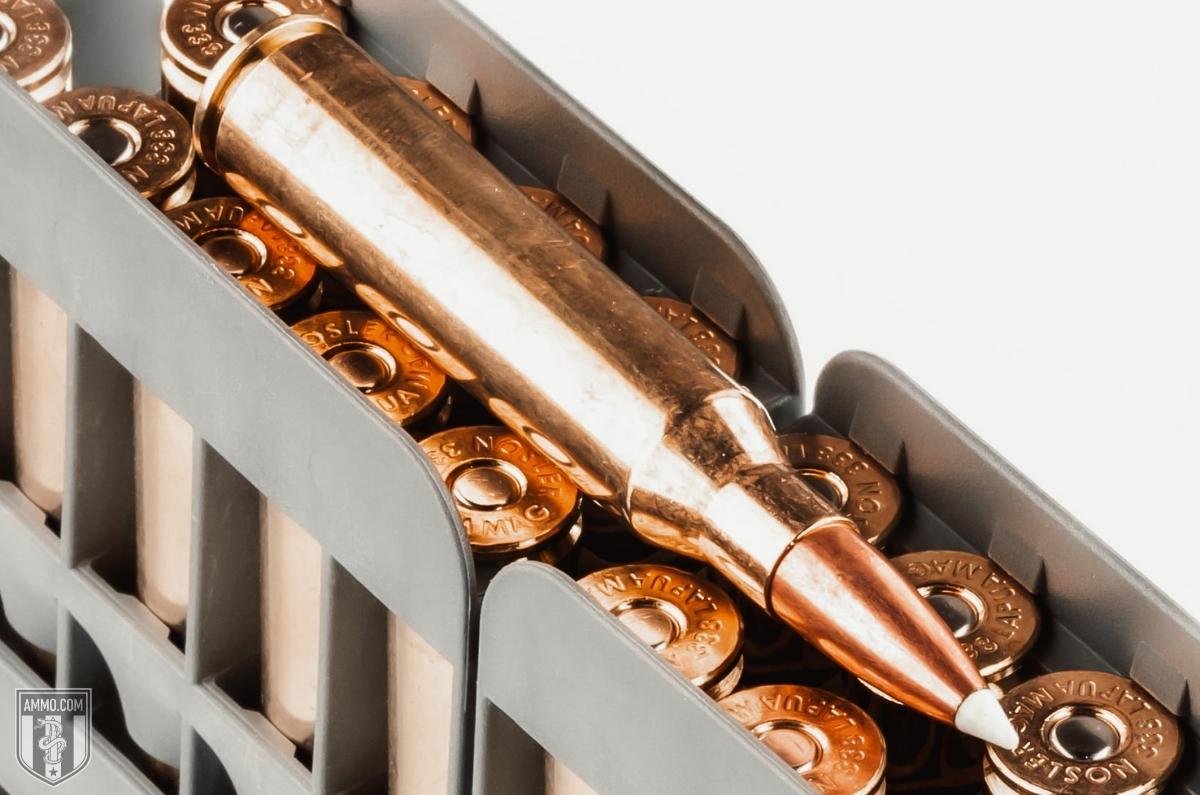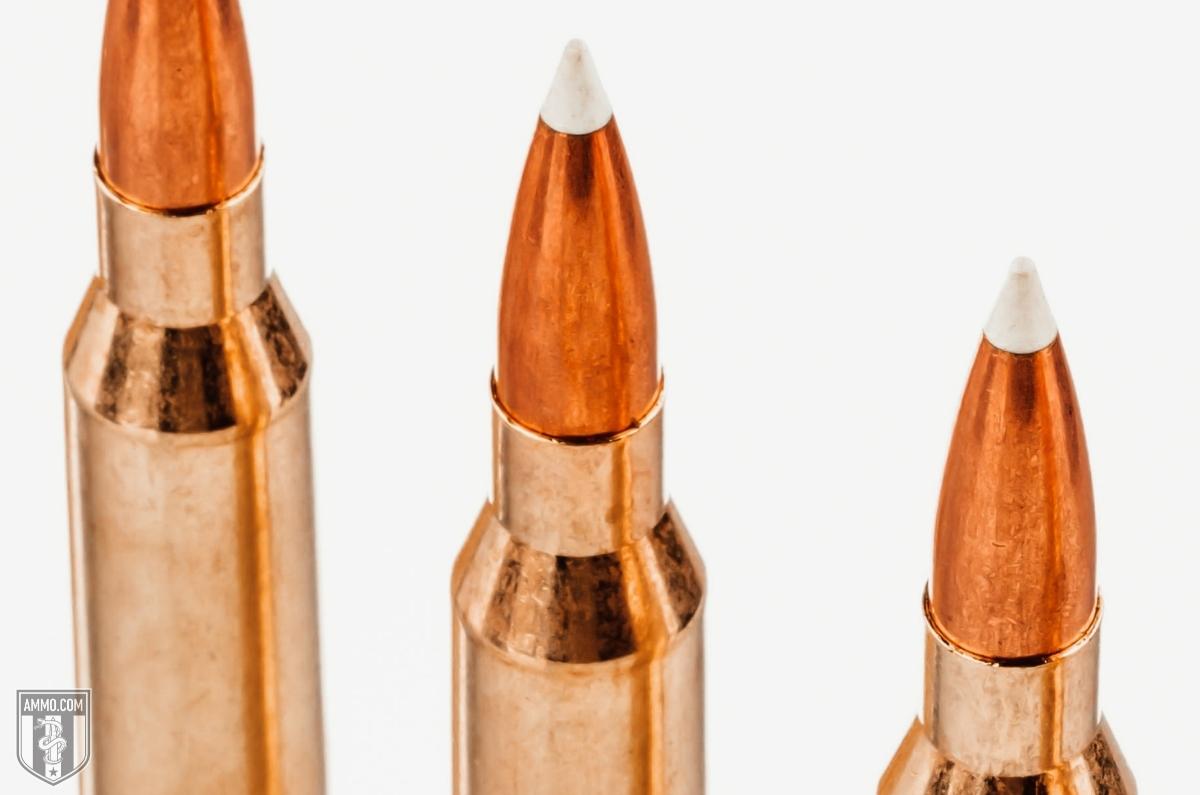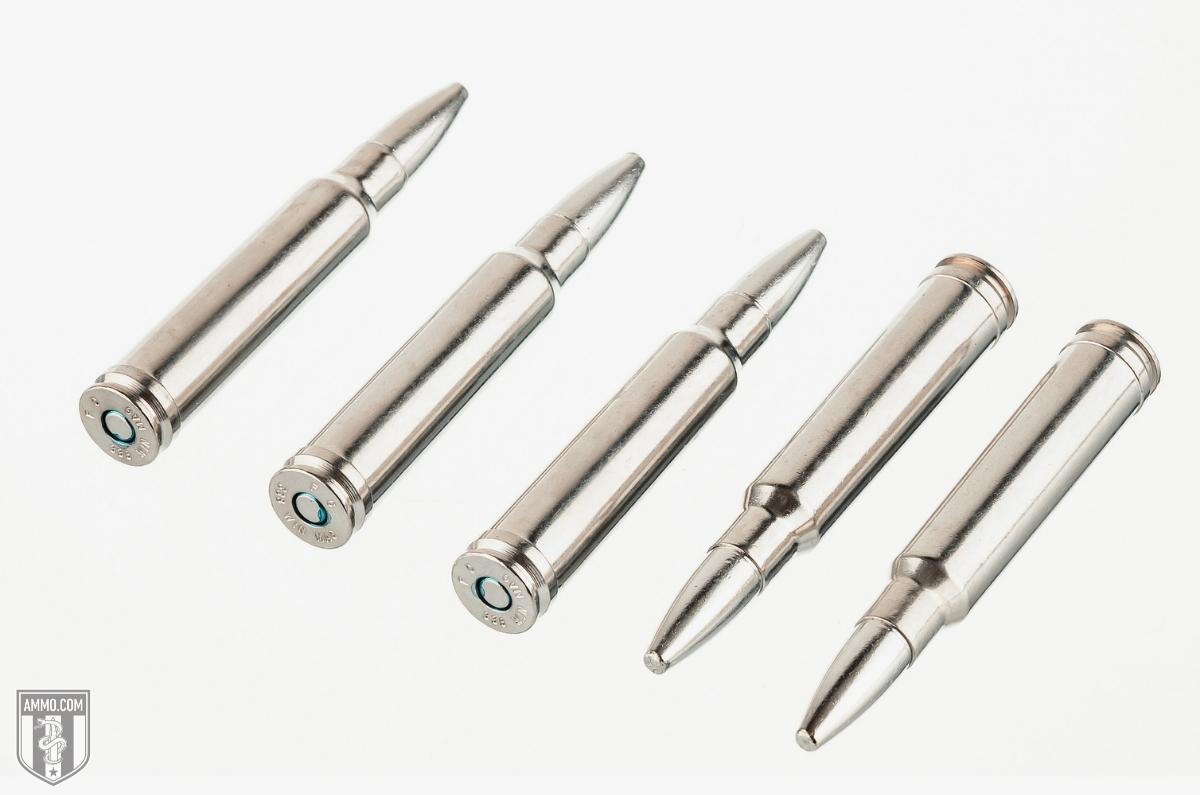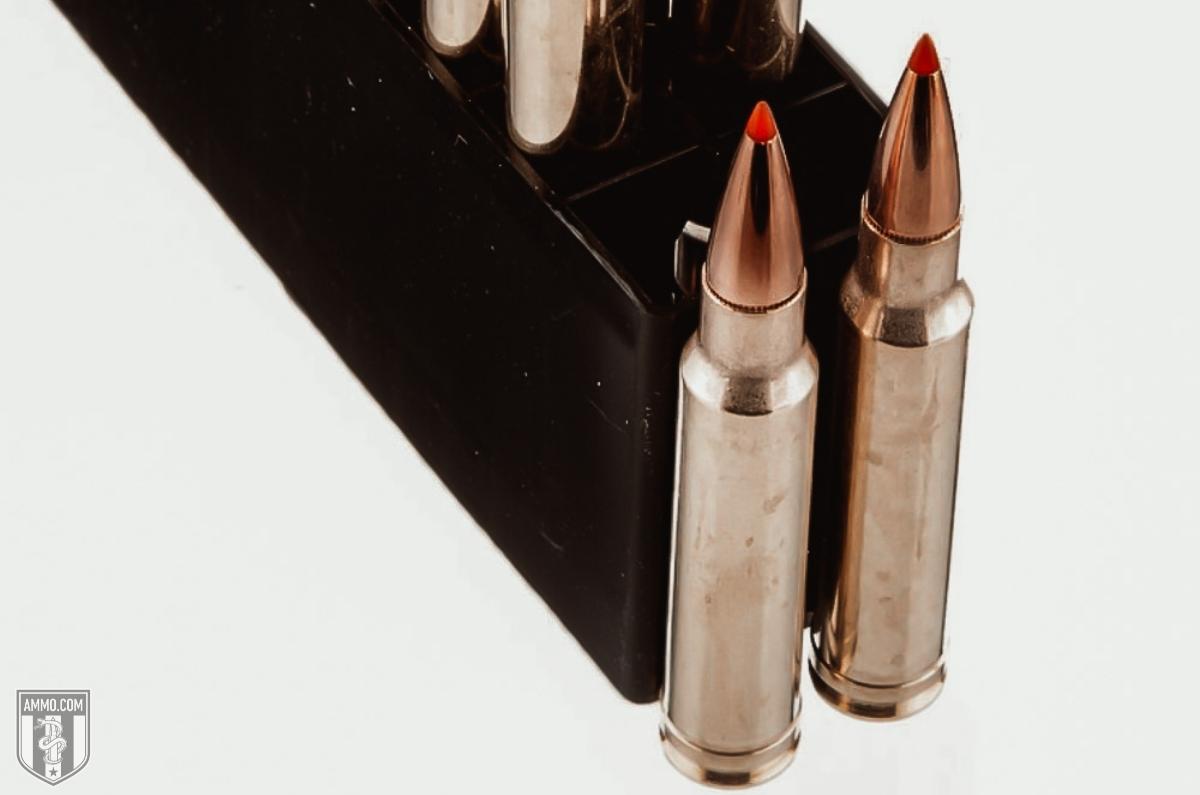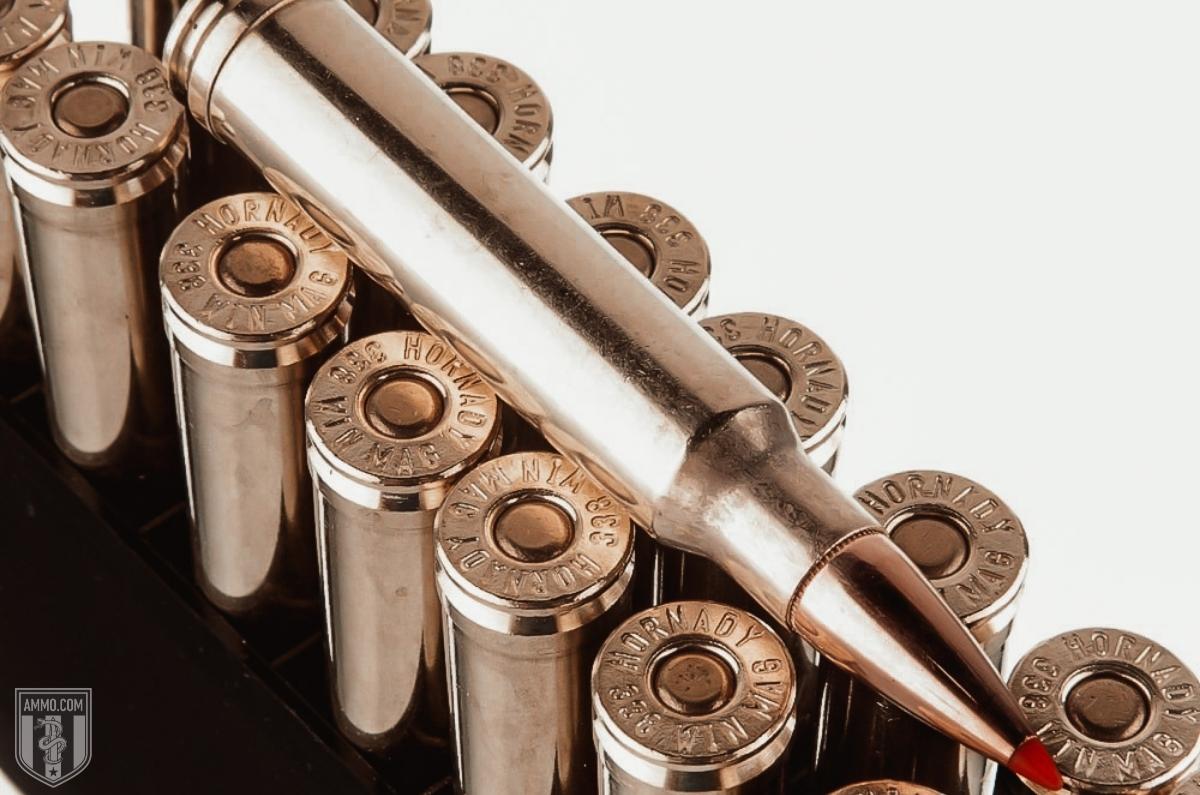338 Win Mag vs 338 Lapua: Loaded for Bear
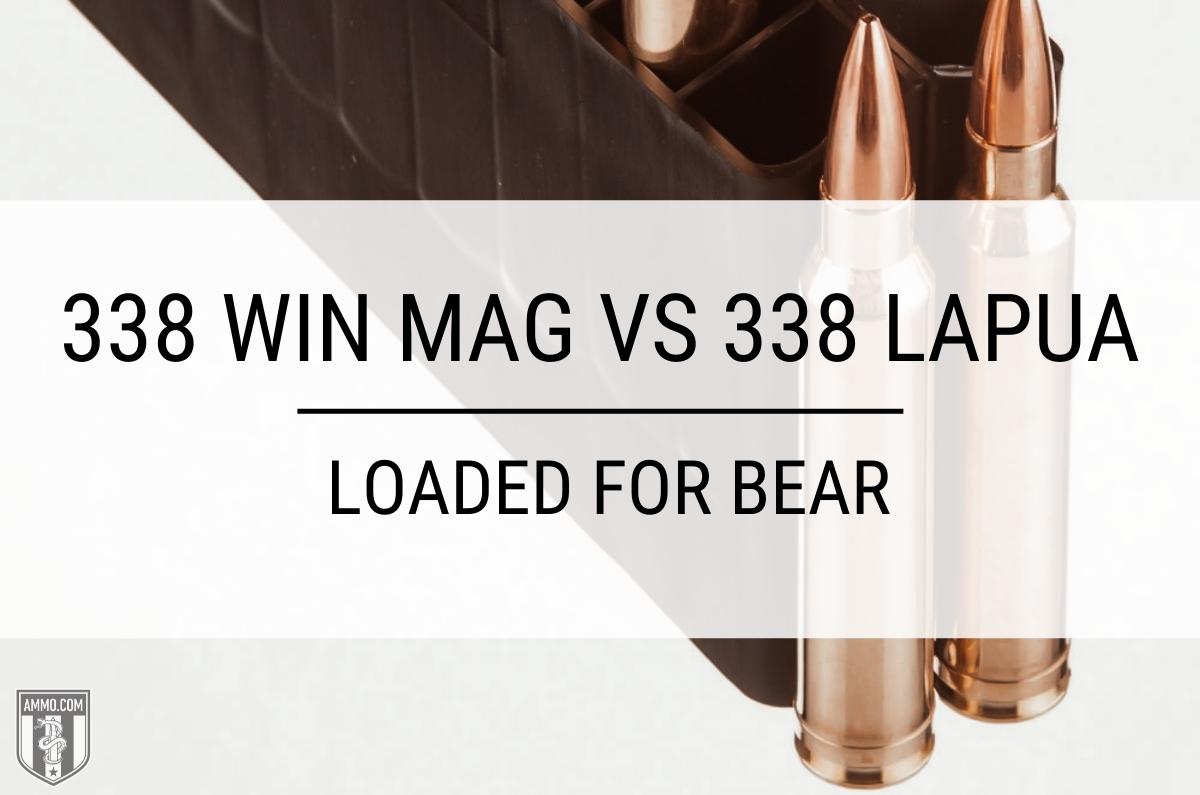 With an effective range of over half a mile, the 338 Lapua Magnum and 338 Winchester Magnum are two centerfire rifle cartridges that excel at long range shooting.
With an effective range of over half a mile, the 338 Lapua Magnum and 338 Winchester Magnum are two centerfire rifle cartridges that excel at long range shooting.
The 338 Lapua Mag is the rifle cartridge of choice for military snipers as it was developed to punch through body armor at 1,000 yards and bridges the gap between the 300 Win Mag and the 50 BMG.
The 338 Win Mag was part of the belted-magnum cartridge craze in the late 50’s and early 60’s and has been the go-to ammo of choice for dangerous game hunters across North America.
Capable of ethically harvesting any thin-skinned game animal on the planet, it is the preferred cartridge in Alaksa to protect yourself against belligerent grizzly bears or other large game. But which of these two magnum cartridges is the best option for your new medium bore bolt-action rifle?
For most non-competitive shooters, the 338 Win Mag will be more than enough cartridge to suit your needs while the 338 Lapua is most at home on the firing line for 1,000+ yard shooting competitions.
In this article, we will examine the advantages and disadvantages of the 338 Lapua and 338 Win Mag to help you understand which will work best for your needs.
What’s the Difference Between 338 Lapua and 338 Win Mag?
The 338 Lapua and 338 Win Mag are two centerfire magnum rifle cartridges that fire the same 0.338” diameter bullets. Although both rifle cartridges fire the same caliber bullets, this is where the similarities between the two ends.
One major difference between the two is the design of the cartridge case. The 338 Win Mag utilizes a belted-magnum design that became popular during the magnum era of the late 1950’s and was marketed for big game hunters while the 338 Lapua uses a non-belted case and was designed specifically for military use.
The 338 Win Mag was also designed to fit into a long action like a 30-06 Springfield, while the 338 Lapua requires a magnum action as it is a longer, beefier round.
Both 338 magnum cartridges excel at long range accuracy and precision, you will not find the 338 Win Mag on the firing line of a 1,000-yard competition that is dominated by 6.5 Creedmoor, 300 Win Mag, and 338 Lapua.
But why is that?
The reason is because the 338 Win Mag is primarily a sporting cartridge while the 338 Lapua is long range precision cartridge. Each have their own roles that they fill admirably and understanding the difference is critical to making the right choice for your next rifle.
In the following sections, we will break down the differences between these 338-caliber magnums so that you can more clearly understand the advantages and disadvantages of each.
Cartridge Specs
When evaluating two big game hunting cartridges, it’s a good idea to analyze the cartridge specs to gain more knowledge of each.
The first, and most obvious, similarity is that both the 338 Lapua Magnum and 338 Winchester Magnum fire the same 0.338” diameter projectiles. However, this is where the similarities end.

One major difference is the case length of both rifle cartridges. The 338 Lapua Magnum has a case length of 2.724” and overall length of 3.681” compared to 2.50” and 3.34”, respectively, for the 338 Win Mag. This difference in case length directly affects case capacity.
The 338 Lapua is well-known for having a cavernous cartridge case. With a case capacity of 114.2 gr, the 338 Lapua can hold over 30% more powder than the 338 Win Mag at 86 gr. This added powder capacity is what allows the 338 Lapua to fire heavier bullets with a higher ballistic coefficient than the 338 Win Mag.
Another difference is the type of rifle action that both cartridges are fired from. With its longer overall length, the 338 Lapua sits firmly in a heavier and stronger magnum action, while the 338 Win Mag is short enough to fit into a long action rifle like the 30-06 Springfield and 300 Win Mag.
At the time of writing, SAAMI has not proofed the 338 Lapua and does not have an established max pressure for the round. To complicate matters, Lapua and the CIP have been somewhat ambivalent about the max pressure for the cartridge.
There is some scholarly debate as to the max pressure for the 338 Lapua, but the lower limits (and therefore safer) suggest 420 MPa (60,916 PSI). The max pressure for 338 Winchester Magnum is 64,000 PSI.
The 338 Lapua is an overall larger case and can fire heavier bullets, and although those projectiles perform extremely well at long distance shooting, there is a price to be paid for this enhanced downrange performance.
The additional case capacity afforded to the 338 Lapua has a negative effect on felt recoil and barrel life when compared to the 338 Win Mag.
Recoil
Recoil is the energy directed towards the shooter when a cartridge is fired from a firearm. For experienced hunters or marksmen, recoil will be a non-issue. However, for less experienced shooters or those who are recoil sensitive, less felt recoil will be preferred.
Lower recoil will also allow shooters to get their sights back on target quicker for follow-up shots. In contrast, heavy recoil can cause shooters to flinch before they pull the trigger, and during long shooting sessions shoulder fatigue can become an issue.
Both magnum cartridges are well known for having stout recoil. The 338 Lapua has so much felt recoil that most manufacturers install a muzzle brake at the factory to help reduce the amount of pounding the shooter’s shoulder receives.
The 338 Win Mag is no slouch when it comes to recoil either. However, this is exacerbated by the fact that most rifles chambered in 338 Win Mag are lighter to make them easier to carry on long hunts.
For this recoil comparison, we will use the Savage 110 Brush Hunter (7.4 lbs) as our 338 Win Mag rifle and the Barrett MRAD (14.5 lbs) for our 338 Lapua Magnum. This comparison will not include the added weight of a scope or bipod as this adds too many variables to the equation.
For a 225 grain Nosler Accubond traveling at 2700 fps, the 300 Win Mag shooter will experience 38 ft-lbs of recoil energy. Now for the 338 Lapua we will consider the 250 grain Nosler Accubond traveling at 2850 fps, which will slap the shoulder at 32 ft-lbs for force.
Now you might look at this and say that the 338 Lapua has lower recoil but note that the rifle is virtually twice as heavy. If we fire the same 338 Win Mag round out of the Barrett the felt recoil would be 20 ft-lbs.
This showcases the extremely different roles that each round serves and the rifles that are used to fit that role.
Barrel Life
Magnum cartridges are notorious for being tough on barrels. Although all that case capacity is great for achieving ridiculous muzzle energy and velocity, it is also will erode the rifling at the chamber throat considerably faster.
Take for example the 300 Remington Ultra Mag (300 RUM) that is reported to burn out a barrel at or below 1000 rounds.
There is a lot of controversy surrounding barrel life and how many rounds a particular barrel can endure before downrange accuracy begins to suffer. One of the major factors that affects this is the powder charge.
If you’re reloading close to max pressure for either round, your barrel will have a shorter lifespan than someone loading milder powder charges.
This is critically important for precision rifle shooters who often engage in extra long range shooting competitions that require the utmost pinnacle of accuracy. These shooters will maintain meticulous records to determine when their barrel is “shot out”, as they will typically see changes in point of impact or their groups opening up when shooting long distance.
For hunters, it’s less likely that you will ever shoot enough to wear out a barrel for either cartridge.
Although it’s difficult to name a specific round count that barrel is good for, the 338 Lapua Mag will generally burn out a barrel faster than the 338 Win Mag as the Lapua round has 30% more case capacity.
Trajectory
Trajectory is how we quantify a bullet’s flight path as it travels downrange measured in inches of bullet drop.
Obviously, a flatter shooting cartridge is preferred for shooting longer ranges, as a shooter will require fewer adjustments to their optics to compensate for bullet drop. Having a flatter trajectory also means that a cartridge will be more forgiving of ranging mistakes.
For this comparison, we will consider the Hornady 250 gr Match 338 Lapua ammo traveling at 2900 fps and Hornady 230 gr ELD-X Precision Hunter ammo screaming out of the muzzle at 2810 fps for 338 Win Mag.
As the 338 Lapua has a higher muzzle velocity, it will reach the intended target faster and thereby be affected by gravity less than the 338 Win Mag.
At 500 yards, both projectiles have almost identical trajectories with the 338 Lapua only being slightly better at -40” of bullet drop compared to -43” for the Winchester Magnum.
However, the 1,000-yard line is what separates the marksmen from the plinkers, coincidentally this is where the 338 Lapua starts to pull away from the 338 Win Mag. At 1,000 yards, the 338 Lapua has experienced -211” of bullet drop compared to -231” for the 338 Win Mag.
Although both the 338 Lapua and the 338 Win Mag have excellent for long range shooting, the 338 Lapua has the flatter trajectory overall.
Ballistic Coefficient
Ballistic coefficient (BC) is a measure of how well a bullet resists wind drift and air resistance. Put another way, it’s a numeric representation of how aerodynamic a bullet is. A high BC is preferred as this means the bullet will buck the wind easier.
Generally, heavier bullets will have a higher BC as it takes more force to disrupt the flight of a heavier bullet than a lighter one. Ballistic coefficient varies from bullet to bullet based on design, weight, and other factors that are beyond the scope of this article.
Since the 338 Lapua can fire heavier projectiles than the 338 Win Mag, the Lapua round will generally have a higher BC.
For example, a 300 grain Nosler Custom Competition 338 Lapua round will have a BC of 0.8 compared to a 225 gr Nosler Expansion Tip for 338 Win Mag with a BC of 0.611.
Although ballistic coefficient will vary between bullets, in general the 338 Lapua will have a higher SD than 338 Win Mag.
Sectional Density
Sectional Density (SD) is the measure of how well a bullet penetrates a target. This is extremely important when hunting big game, as you need a bullet that can punch through thick hide, bone, and sinew.
Sectional density is calculated by comparing the bullet weight and the bullet diameter. The higher the SD the deeper the bullet will penetrate into the target. This is a simplified view of penetration as there are other factors to consider, such as bullet expansion and velocity.
Let’s look at the Hornady Precision Hunter line for an apples-to-apples comparison.
The 270 gr ELD-X for 338 Lapua has a SD of 0.338 while the 230 gr ELD-X for 338 Win Mag has a SD of 0.288.
As the 338 Lapua typically has a higher muzzle velocity than the 338 Winchester Magnum, it will often have the higher SD.
Hunting
Determining the superior round for hunting has been debated ad nauseum in online forums, around campfires, and at gun store counters. There are clear merits to both the 338 Lapua and Winchester Magnum in terms of hunting efficacy.
However, the 338 Win Mag is the better choice in terms of hunting large game. I know a lot of Lapua fans are lighting their torches and sharpening the pitchforks but let me explain why.
The first reason is rifle design.
Generally, 338 Win Mag rifles are lighter and easier to carry into deep brush. This is why so many Alaskan guides carry them as a deterrent to dangerous game, it’s a light-weight rifle that packs a massive punch.
Would a 338 Lapua be good against bears? Absolutely. But carrying a rifle weighting 12+ lbs is a lot more difficult than carrying one that is 7 lbs. Rifles for 338 Lapua were intentionally built heavier to handle the massive strain the cartridge puts on the rifle action and to reduce felt recoil.
All that weight might be perfectly fine for long distance shooting from a bench, but it’s not so helpful when you’re carrying it miles on end. In this situation, having a lighter and maneuverable rifle is preferred to having one that is bulkier, longer, and harder to carry.
The second reason is cost.
Many big game hunters will scoff at the concept of cost, stating that ammo expenditures are minimal when only going through a few boxes a year. And I’d agree with that.
However, if I told you that you could get identical performance for a lower cost, I’m guessing most of my readers would take that deal. I know I would!
When comparing the same brand of ammo, the 338 Win Mag will almost always be the lower cost option.
And let’s not forget the rifle cost as well. Your regular run of the mill bolt action rifle from Savage, Weatherby, Sako, or Ruger for 338 Win Mag will typically cost you under $1,000. But you should expect to spend no less than $2,000 for a rifle chambered in 338 Lapua.
The third and final reason, is terminal ballistics.
Fans of the 338 Lapua will be at the ready to tell me that the 338 has better terminal ballistics than the Win Mag, and they are correct in this.
But will that big game animal be able to tell the difference? I highly doubt it.
The 338 Lapua is simply more than you need for large game across North American.
Now if you fancy flying across the pond to take on The Big 5 in Africa, then the 338 Lapua would be the better option. For those extra-large dangerous game animals, you’ll want as much stopping power as you can get and the 338 Lapua can deliver that for you.
For North America, 338 Win Mag is more than enough. For the dangerous game of Africa, 338 Lapua is a suitable choice (though most will use 375 H&H Magnum, 416 Rem Mag, or 458 Lott).
Ammo and Rifle Availability/Cost
As mentioned previously in the Hunting section, the 338 Win Mag is the better option when it comes to cost for both rifles and ammo.
Ammo for the 338 Win Mag runs around $4-6/round depending on the manufacturer and grade. Match ammo and premium hunting ammo will typically garner a higher price than bulk practice ammo.
For 338 Lapua, you should expect to generally pay around $5/round for the cheap stuff and upwards of $10/round for hunting and match grade ammo.
In terms of availability, as the 338 Lapua is a military round, it is a bit more plentiful than 338 Win Mag. However, all of the major manufacturers like Hornady, Federal, Remington, and Nosler make ammo for both calibers.
Although ammo might be a bit easier to find for 338 Lapua, there are considerably more varieties and affordable rifle options for 338 Win Mag since it is a hunting round. Weatherby, Remington, Savage, Ruger, and Sako all make bolt-action rifles for 338 Win Mag that can be had for under $1,000.
Good luck finding a 338 Lapua rifle for less than $2000 out the door!
As the 338 Lapua is a more powerful round, it required reinforcement in the action to handle the pressures and recoil that the cartridge can produce. This requires more material and therefore increases cost. Furthermore, most Lapua rifles are accurized by a gunsmith as the round is designed to be shot at long range. This also drives up the price.
There are fewer manufactures who offer rifles in 338 Lapua but that number is growing. The major players in terms of 338 Lapua rifles would be Barrett, Accuracy International, GA Precision, Ruger, and Savage.
Reloading
Reloading is one way to reduce the overall cost per round of your ammo. Furthermore, reloading allows you to tailor your ammo to your individual rifle, allowing you to achieve sub-MOA results without eating the cost that match grade ammo commands.
Both of these 338 rifle cartridges will devour powder, so make sure that you’re ordering in bulk to ensure you get the best price.
Although the 338 Lapua and 338 Win Mag fire the same caliber bullets, there isn’t as much overlap in the grain weights that they use when compared to other cartridges like the 308 Winchester and 300 Win Mag. The 338 Lapua typically fires bullets between 250 and 300 grains while 338 Win Mag can fire between 200 and 275 grains, with 225 grain bullets being the most popular.
Ballistics: 338 Win Mag vs 338 Lapua
Our team here at Ammo.com has spent countless hours scouring the Internet to bring you extremely comprehensive ballistics tables for both calibers. These tables will compare bullet weight to muzzle velocity, muzzle energy, and trajectory.
338 Win Mag Ballistics
| 338 Win Magnum Bullet WEIGHT | Muzzle VELOCITY (fps) | Muzzle ENERGY (ft. lbs.) | TRAJECTORY (in.) | |||||||||||
|---|---|---|---|---|---|---|---|---|---|---|---|---|---|---|
| Muzzle | 100 yds. | 200 yds. | 300 yds. | 400 yds. | Muzzle | 100 yds. | 200 yds. | 300 yds. | 400 yds. | 100 yds. | 200 yds. | 300 yds. | 400 yds. | |
| 185 Grain Superformance | 3080 | 2850 | 2632 | 2424 | 2226 | 3896 | 3337 | 2845 | 2413 | 2034 | 1.4 | 0 | -6.4 | -18.8 |
| 200 Grain | 3030 | 2820 | 2620 | 2429 | 2246 | 4077 | 3532 | 3049 | 2621 | 2240 | 1.4 | 0 | -6.5 | -18.9 |
| 210 Grain | 2830 | 2590 | 2370 | 2150 | 1940 | 3735 | 3130 | 2610 | 2155 | 1760 | 2.5 | 1.4 | -6 | -20.9 |
| 225 Grain | 2785 | 2517 | 2266 | 2029 | 1808 | 3871 | 3165 | 2565 | 2057 | 1633 | 2.5 | 0.4 | -8.5 | -25.9 |
| 225 Grain Superformance | 2840 | 2758 | 2582 | 2414 | 2252 | 4318 | 3798 | 3331 | 2911 | 2533 | 1.5 | 0 | -6.8 | -19.5 |
| 230 Grain | 2780 | 2573 | 2375 | 2186 | 2005 | 3948 | 3382 | 2881 | 2441 | 2054 | 2.5 | 1.2 | -6.3 | -21 |
| 250 Grain | 2660 | 2456 | 2261 | 2075 | 1898 | 3927 | 3348 | 2837 | 2389 | 1999 | 2.5 | 0.2 | -9 | -26.2 |
| 250 Grain Ultra | 2860 | 2645 | 2440 | 2244 | 2057 | 4540 | 3882 | 3303 | 2794 | 2347 | 1.7 | 0 | -7.6 | -22.1 |
338 Lapua Ballistics
| 338 Lapua Magnum Bullet WEIGHT | Muzzle VELOCITY (fps) | Muzzle ENERGY (ft. lbs.) | TRAJECTORY (in.) | |||||||||||
|---|---|---|---|---|---|---|---|---|---|---|---|---|---|---|
| Muzzle | 100 yds. | 200 yds. | 300 yds. | 400 yds. | Muzzle | 100 yds. | 200 yds. | 300 yds. | 400 yds. | 100 yds. | 200 yds. | 300 yds. | 400 yds. | |
| 250 Grain | 2900 | 2685 | 2481 | 2285 | 2098 | 4668 | 4002 | 2416 | 2899 | 2444 | 1.7 | 0 | -7.3 | -21.3 |
| 250 Grain | 2963 | 2795 | 2640 | 2493 | n/a | 4842 | 4341 | 3881 | 3458 | n/a | 1.9 | 0 | -7.9 | 0 |
| 250 Grain Match | 2900 | 2760 | 2625 | 2494 | 2366 | 4668 | 4229 | 3825 | 3452 | 3108 | 1.5 | 0 | -6.6 | -18.8 |
| 285 Grain | 2745 | 2616 | 2491 | 2369 | 2251 | 4768 | 4331 | 3926 | 3552 | 3206 | 1.8 | 0 | -7.4 | -21 |
| 285 Grain Match | 2745 | 2623 | 2504 | 2388 | 2275 | 4768 | 4352 | 3966 | 3608 | 3275 | 1.8 | 0 | -7.3 | -20.8 |
| 300 Grain | 2660 | 2544 | 2432 | 2322 | n/a | 4715 | 4313 | 3940 | 3592 | n/a | 1.9 | 0 | -7.8 | n/a |
A Brief History of 338 Winchester Magnum
The 338 Winchester Magnum was introduced in 1958 by the Winchester Repeating Arms company.
The 338 Win Mag is a belted magnum cartridge that draws its heritage from the 375 H&H Magnum round that was also used in the development of the 264 and 458 Winchester Magnum cartridges released in the same year.
The introduction of the 338 Win Mag sparked the “Magnum Era” in terms of cartridge design, and the other bullet manufacturers were not about to let Winchester go unchallenged. Weatherby was quick to introduce the 340 Weatherby Magnum as a direct competitor to the 338 Win Mag, but it was Remington’s release of the 7mm Rem Mag that made the biggest splash and prompted the development of the 300 Win Mag in 1962.
Although the 338 Win Mag was marketed to big game hunters as a medium bore cartridge capable of taking on grizzlies, it was not immediately a commercial success. However, as time passed it has become the top choice for Alaskan hunting guides working in bear country.
Capable of pushing a 225-grain bullet at 2,800 fps with 3,918 ft-lbs of energy, the 338 Win Mag is a heavy hitting cartridge capable of taking down any game animal on the planet.
A Brief History of 338 Lapua Magnum: The 50 BMG Lite
Development of the 338 Lapua Mag began in 1983 by US-based company, Research Armament Industries (RAI). Their goal was to create a cartridge that bridged the gap between the 300 Winchester Magnum and the 50 BMG.
The design specification required that the cartridge be able to penetrate 5 layers of military-grade body armor at 1000 meters and fire a 0.338” diameter bullet for its ideal sectional density and ballistic coefficient. The targeted muzzle velocity to meet these goals was 3,000 fps.
Initial designs for the 338 Lapua Magnum utilized the 416 Rigby as a parent case, simply necking it down to accept a 250 grain Hornady A-MAX bullet. Sadly, the 416 Rigby case was not strong enough to withstand the pressures needed to achieve RAI’s ballistic goals.
By 1984, RAI was under pressure from the military to finish their work and in desperation they reached out to the Finnish ammo company, Lapua, for assistance. Straddled with debt, RAI had to drop out of the program, and this left the fate of the new cartridge in the hands of the engineers at Lapua.
The ballistics team at Lapua joined forces with Sako and Accuracy International to work on redesigning the 416/338 case so that it could handle 60,000 psi of pressure.
The final case design was an extremely pressure resistant that was able to achieve velocities just short of the initial 3,000 fps goal. The decision was also made to depart from Hornady bullets, utilizing a new bullet design instead, the LockBase B408 FMJ.
The finalized 338 Lapua Magnum cartridge submitted and accepted by the CIP (the European version of SAAMI) in 1989 and became a NATO cartridge shortly thereafter.
NATO standard 338 Lapua Mag ammo fires a 250-grain bullet with a muzzle velocity of 3000 fps and muzzle energy of 4892 ft-lbs.
Precision rifle shooters who like to air it out to 1000 yards or more will appreciate the 338’s ability to easily remain supersonic past 1400 yards and maintain MOA levels of accuracy. While the 338 Lapua has a trajectory that would make any 6.5 Creedmoor or 300 Win Mag shooter green with.
The 338 Lapua Mag is a powerhouse of a round and will be competing with the 50 BMG for years to come.
Final Shots: 338 Lapua vs 338 Win Mag
The 338 Lapua and 338 Win Mag are both extremely hard-hitting rifle cartridges that have an insane effective range of over half a mile. They have proven themselves countless times in the woods, the battlefield, and on the firing line at precision rifle competitions.
The 338 Lapua is a round specifically designed with military snipers in mind. It has an incredibly flat trajectory and cut its teeth in the deserts of the Afghanistan during Operation Enduring Freedom. Although the Lapua has seen most of its action overseas, it is becoming more popular on the civilian market for long range shooting competitors who want to reach out past 1,000 yards.
The 338 Winchester Magnum has proven itself against big game animals for over half a century and is still going strong. It’s the favored cartridge of Alaskan hunting guides for its persuasive power against disgruntled grizzly bears and angry bull moose. Bolt-action rifles for 338 Win Mag are light and maneuverable, making them ideal for long stalks or in a tree stand.
Although the 338 Lapua has superior external ballistics, most civilian shooters will be well served by the 338 Win Mag due to its lower overall cost and an effective range well outside ethical hunting distances. This is not to say that you shouldn’t get a 338 Lapua if you can afford it or if it’s something that you’ve always wanted. The Second Amendment ensures this right, and you should use it every chance you get.
Ammo Comparisons
- .308 vs 5.56
- 6.5 Creedmoor vs .308
- .300 Blackout vs .308
- .300 Win Mag vs .308
- .243 vs .308
- .308 vs .30-06
- 7mm-08 vs .308
- .270 vs .308
- 7.62x39 vs .308
- .223 vs .308
- .338 Lapua vs .308
- .380 ACP vs 9mm
- .223 vs 5.56
- .300 Blackout vs 5.56
- 9mm vs 45 ACP
- 9mm vs 40 S&W
- .357 SIG vs 9mm
- 10mm vs 9mm
- 9mm vs 9mm Luger
- .243 vs .270
- .300 Win Mag vs .30-06
- .270 vs .30-06
- .40 vs .45
- 38 Special vs 357
- 9mm vs 40 vs 45
- 5.56 vs 7.62x39
- 338 Lapua vs .30-06
- .30-30 vs .30-06
- 300 PRC vs 338 Lapua
- .30-06 vs 7mm
- 300 Win Mag vs 338 Lapua
- 300 PRC vs 300 Win Mag
- 300 WSM vs 300 Win Mag
- 338 Win Mag vs 338 Lapua
- 12 Gauge vs 20 Gauge
- 10mm vs 357 Mag
- .30-30 vs 7.62x39
- 224 Valkyrie vs 22-250
- 17 HMR vs 22 Mag
- 7.62x39 vs .300 Blackout
- 45 ACP vs 45 Auto
- 45-70 vs 30-30
- 300 Blackout vs 223
- 357 Magnum vs 9mm
- 350 Legend vs 300 Blackout
- 224 Valkyrie vs 223
- 45 ACP vs 38 Super
- 6.5 Grendel vs .308
- 17 HMR vs 22 LR
- 10 Gauge vs 12 Gauge
- 22-250 vs 223
- 45 Colt vs 45 ACP
- 350 Legend vs 30-30
- 5.7x28 vs 223
- 5.7 vs 9mm
- 5.56 vs 5.7
- 22 vs 9mm
- Buckshot vs Birdshot
- 450 Bushmaster vs 308
- 450 Bushmaster vs 223
- Buckshot vs Slug
- 6.5 Grendel vs 5.56 vs 223
- 6mm ARC vs 6.5 Grendel
- 44 vs 45
- 458 SOCOM vs 5.56
- 357 vs 44
- 32 ACP vs 380
- 300 Win Mag vs 338 Win Mag vs 338 Lapua Mag
- 450 Bushmaster vs 458 SOCOM vs 50 Beowulf
- 6mm Creedmoor vs 6.5 Creedmoor
- TMJ vs FMJ
- 44 Special Vs 44 Magnum
- 45 90 vs 45 70
- 6.8 Western vs 6.8 SPC
- 50 Beowulf vs 50 BMG
- 26 Nosler vs 6.5 PRC
- 28 Gauge vs 410
- 6.8 SPC vs 5.56
- 6.8 SPC vs 6.5 Grendel
- 6.8 Western vs 7mm Rem Mag vs .28 Nosler
- 6.8 Western vs 6.5 Creedmoor
- 22 Hornet vs 223
- 6.8 Western vs 6.5 PRC
- .410 vs 12 Gauge
- .410 vs 20 Gauge
- 22 LR vs 22 Mag
- 6mm ARC vs 243
- 7mm-08 vs 270
- 243 vs 6.5 Creedmoor
- Nickel vs Brass Casing
- 204 Ruger vs 223
- 50 Beowulf vs 5.56
- 260 Remington vs 6.5 Creedmoor
- 6mm Remington vs 243
- 28 Nosler vs 300 PRC
- 50 Beowulf vs 50 AE
- 22 Nosler vs 22-250
- 450 Marlin vs 45-70
- 300 Win Mag vs 300 Norma
- 458 SOCOM vs 300 Blackout
- 38-55 vs 45-70
- 22 Hornet vs 22 LR
- 300 Norma vs 338 Lapua
- 338 Lapua vs 50 BMG
- 28 Nosler vs 300 Win Mag
- 28 Nosler vs 6.5 Creedmoor
- 204 vs 22-250
- 458 SOCOM vs 45 70
- 44 40 vs 45 70
- 6.8 SPC vs 6.5 Creedmoor
- 450 Bushmaster vs 30-06
- 7mm Rem Mag vs 300 Win Mag
- 30 Carbine vs 223
- 25-06 vs 30-06
- 26 Nosler vs 28 Nosler
- 16ga vs 12ga
- 30 06 vs 7.62 x54R
- 9mm Makarov vs 9mm Luger
- 350 Legend vs 223
- 30 Carbine vs 5.56
- 6.5x55 vs 6.5 Creedmoor
- 6.5 Creedmoor vs 270 vs 25-06
- M193 vs M855
- 450 Bushmaster vs 458 SOCOM
- 6.5 Grendel vs 6.5 Creedmoor
- 350 Legend vs 5.56
- .277 Fury vs 6.8 SPC
- 277 Fury vs 300 Win Mag
- 10mm vs .45 ACP
- 277 Fury vs 223
- 6.8 SPC vs 300 Blackout
- 6.5 PRC vs 6.5 Creedmoor
- 277 Fury vs 308
- 277 Fury vs 6.5 Creedmoor
- 350 Legend vs 450 Bushmaster
- 277 Fury Vs 5.56 NATO
- 10mm vs 40S&W
- 32 ACP vs 9mm
- 32 Special vs 9mm
- 8.6 Blackout vs 300 Blackout
- 30 Super Carry vs. 9mm
- 5.56 vs 9mm
- .50 Action Express vs 9mm
- 7.62x25 vs. 9mm
- 10mm vs 44 Magnum
- 300 Blackout vs 300 Win Mag
- 6.5 Grendel vs 300 Blackout
- 460 Rowland vs 10mm
- 300 RUM vs 300 PRC
- 300 Norma vs 300 PRC
- 45 GAP vs 45 ACP
- 7mm PRC vs 300 Win Mag
- 300 PRC vs 6.5 Creedmoor
- 300 PRC vs 308
- 357 SIG vs 357 Mag
- 7.62x39 vs 7.62x51
- 243 Win vs 223 Rem
